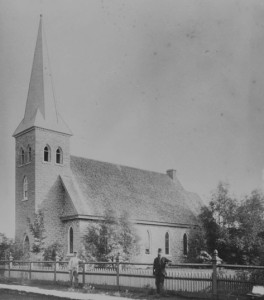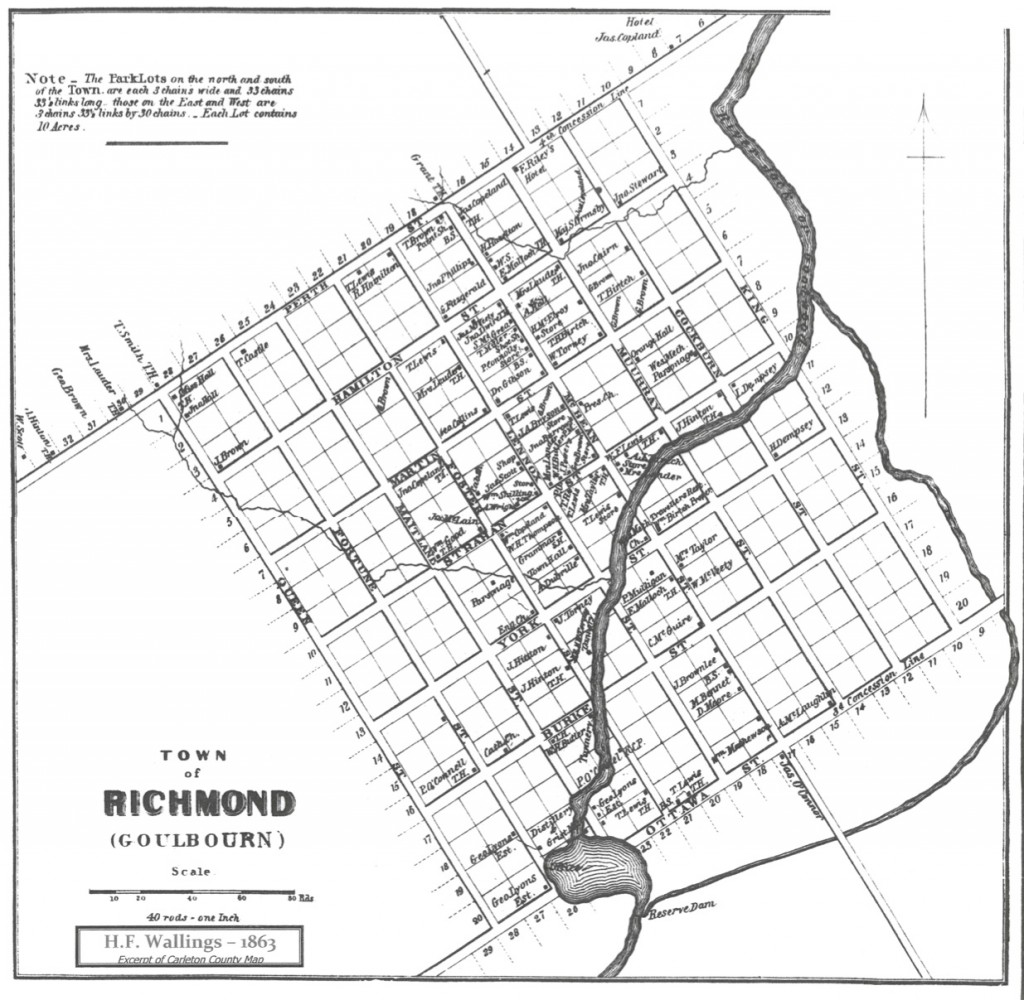To honour Richmond’s 200th anniversary, we will be posting factoids about our rich history. You should expect to see 200 pieces of information that you may or may not have already known. The topics of these posts are: #96. The stone St. John’s Church #97. The Drill Hall #98. The Walling Map #99. The Fraternal Societies #100. May 1868 Holiday
If you have a question about the source of a factoid please contact us.

The steeple was not part of the original construction
(courtesy GTHS)
Factoid #96. Two years after the Roman Catholic congregation built a new stone church, the Anglicans finalized plans to build a similar style building. An examination of the list of contributors to the building fund reveals the extent to which the original military elite and the children of the leaders showed their loyalty to their community. Several of the largest donors no longer lived in the village. Mrs. Henrietta Lauder and her brother John Bower Lewis both lived in Ottawa but still contributed large sums of money. Their mother, the widow of Capt. John Lewis paid for the stone floor, which is apparently still to be found under the current wooden flooring. Edward Malloch, also an Ottawa resident and an ardent Presbyterian, whose wife Margaret (nee Hill) had been raised in the Anglican congregation, donated $100 while many parishioners were only able to give $1.
Whereas the original log church had faced York St. about half way along the block between Fowler St. and Maitland St., the new church was to the east, facing Fowler St. St. John’s church was built in a combination of styles popular at the time. The basic construction was symmetrical (Georgian influence) with the entrance placed in the gable end. The steep roof and arched windows were similar to the Gothic Revival style of the age.
The interior of the church evolved over time and it might surprise some readers to learn that there was once a loft accessed by stairs near the entrance
Factoid #97. The existence of a local militia has been mentioned several times in earlier factoids. These militias came and went as the threat of an invasion from the United States heightened or diminished. In the 1860s the major danger was an invasion of Canada by the radical Fenian society. This was a group of American based Irish nationalists who planned to invade and capture Canada and exchange it for the end of British control of Ireland. The Fenians were not a harmless threat; they did in fact launch attacks.
In Richmond a Militia company was formed. Oral histories recount that the militia actually used the abandoned log Anglican Church as a drill hall.
Loyalist feelings were strong, and more than 50 area men formed the Richmond Company.

Factoid #98. In 1863 H. F. Walling created a wall map (of Carleton County), which included a detailed enlargement of Richmond. The map showed the location and owners of buildings, of both major and minor importance and provided a treasure of information for researchers.
It is this map that recorded that both a Town Hall and a Grammar School had been built on the west side of Lennox St. between Strachan St. and the Jock River. (This information has been confirmed by written references.) This was a departure from the traditional location on the administration block. The buildings were here for approximately 20 years until new ones were constructed on the old Cockburn St. site. It is not know why the Lennox St. location was abandoned. Could the fact that it was in the floodplain have been a factor?
The map also provided information about the social makeup of the village. For example a close examination reveals several properties with the label T. Lewis T. H. These were properties owned by Thomas Lewis the merchant son of Capt. John Lewis. The T.H. indicated that the property had a house inhabited by a tenant. Thus we know that Mr. Lewis had income other than that of his store.
The map also showed that there was no rectory beside St. Philip’s Church. Rather, Rev. P. O’Connel(l) lived on Fortune St., south of the Jock River. Other evidence shows that his brother, a farmer, also lived at that location.
These are only three of many pieces of information one can gain from an examination of this important source.
Factoid # 99. In the nineteenth century, there was no social safety net nor was there a formal banking system in the village. Both the Masonic order and the Orange Lodge helped fill these voids. Both groups had been active in the village in the first years of settlement but both were disbanded as interest waned. The Orange Lodge was revived in the late 1830s and the Masonic Lodge in the 1860s. Both were known to provide support to people in need: the ill and elderly, as well as orphans and widows. Better off members of the organizations lent money to their “brothers” who needed support. In the 1860s both groups were said to have held meetings in the area above Patrick McElroy’s store.
Factoid #100. An article, which appeared in the Ottawa Citizen on Friday May 25 1868, recounted a celebration held in the village on the preceding Monday. “Monday was observed as a general holiday in the Village of Richmond. All places of business were closed and work generally suspended, and flags liberally displayed over the various public buildings among which we may mention the Town Hall, Drill Shed and the Orange Lodge Room.”
So it seems probable that the Union Jack was proudly displayed on Lennox St. It is also possible that the other two sites mentioned were the old Anglican Church building (drill shed) and Patrick McElroy’s store (Orange Lodge Room).
